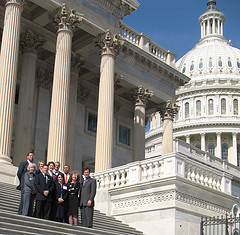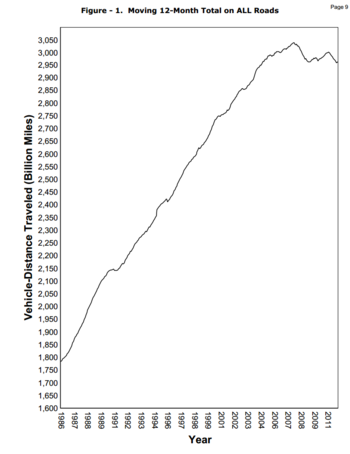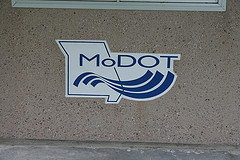Solution to federal government budget shutdown may impact federal transportation funding; Missouri's $8 billion transportation funding plan
Will the resolution to the current Congressional budget impasse threaten MAP-21, the federal transportation funding bill? Transportation Issues Daily thinks it is a possibility:

A bipartisan proposal to help resolve the current budget impasse may threaten funding and renewal of MAP-21, the federal surface transportation act. The proposal involves taking over a provision that helps pay for MAP-21, according to a report in Congressional Quarterly (note: story may be paywalled).
Here is the story in short:
Since the federal gas tax hasn't been raised in 20 years, and loses buying power by a few percent each year because is doesn't have an automatic inflation adjustment, when MAP-21 was passed last summer, Congress balanced the very large deficit in transportation spending by sweeping up savings from some large federal trust funds.
Those funds are currently enjoying huge savings because of historically low interest rates, which creates budget surpluses that Congress can use to balance the budgets of various programs.
Now those same fund savings are being eyed by members of Congress as they look for ways out of the current federal budget impasse. Congress might take those future savings and use them for other budget balancing, leaving the MAP-21 or its successor high and dry.
The problem: MAP-21 renewal already faced a large budget deficit even with the new trust fund dollars. If those dollars are gone as the result of current budget negotiations, MAP-21 renewal will face a truly massive budget shortfall--one that will make it very difficult to pass a MAP-21 renewal.
MAP-21 was only a two year bill--so it is up for renewal next year.
Federal gas tax notes 20 year anniversary--U.S. gas taxes last raised in 1993
Meanwhile, last week transportation advocates noted the twenty year anniversary of the last federal gas tax increase.
To have the same buying power as the 1993 of 18.4 cents per gallon, our current federal gas tax would need to be raised by 11.4 cents per gallon.
To put it another way, if we translated our current 18.4 cents per gallon federal gas tax 2013 back to 1993 dollars, the 1993 rate would be only 11.4 cents per gallon.
To put it another way, we need to raise our current gas taxes by 50% to put them back at the same level they were in 1993. Right now we're trying to fund our entire transportation system with that amount of money missing--and the buying power of the tax dollars collected going down every year.
And that doesn't take into consideration another factor diluting the buying power of the fuel tax: Gas mileage has been increasing over the years, meaning that the effective amount of tax paid per mile driven has been declining at a rate even faster than inflation.
Either way you look at it, over the past 20 years Americans have enjoyed a pretty substantial automatic annual cut in our effect federal gas tax rates and the effective buying power of our federal gas tax is very near a historical low.
That's helped our personal pocketbooks a little, but it has put the federal transportation funding system into a serious crisis--and one that few politicians seem interested in addressing.
The Hill's story on the transportation funding situation made these points:
“The shutdown of the federal government will have long-lasting negative effects on America’s already outdated infrastructure,” American Society of Civil Engineers Gregory DiLoreto said in a statement. . . .
“America’s transportation infrastructure is on a collision course unless Congress takes swift action to approve a long-term revenue solution,” he said. “The Highway Trust Fund will be bankrupt by 2015 and MAP-21 is set to expire in September 2014. Infrastructure projects are already being put on hold because of the uncertainty of federal funding.”
How this affects bike/ped transportation and funding
Three important notes about this situation from the bike/ped perspective:

- For decades, transportation engineers and planners have balked at the idea of spending dollars collected from fuel taxes for any form of transportation other than roads and highways for motor vehicles.
There were strong arguments against that idea even in the past, when the vast majority of transportation funding did come from fuel taxes.
But today, a huge portion of federal transportation funding comes from bonds and other general tax funds, rather than from user fees such as fuel taxes. Since 2007, the last year shown on the chart above, the proportion of federal transportation dollars paid by fuel taxes has decreased even more. Today, less than 50% of federal transportation dollars come from user fees like the gas tax.
Because of this, we can now say that the argument that "federal transportation is paid by user fees and should benefit users (ie, motor vehicle drivers) only" is completely dead.
Nonmotorized users not only pay their fair share into the system--now they are paying far more than their fair share.
Building our communities to be safe and accommodating for bicycling, walking, and transit has always been the right thing to do. But now we can also make the case that those who walk, bicycle, and/or use transite for many of their trips are paying far more than our fair share into the federal transportation funds. And that is a strong argument for ensuring that we get our fair share of benefits out of the system! - Though the American Society for Civil Engineers makes a strong case for a huge deficit in infrastructure spending in the United States in recent years, there is a flip side to that case: All too often, the civil engineers and highway designers are still living in the late 20th Century, when the growth in American demand for roads and highways seemed insatiable.
 Motor Vehicle Miles Driven in the U.S., 1986-2011 (FHWA)
Motor Vehicle Miles Driven in the U.S., 1986-2011 (FHWA)
Many planners and engineers are still making the assumption that the amount of miles driven by Americans has no upper limit, and will just keep going up, up, and up.
But, as we have pointed out before, America is now well past its hyper-inflationary stage of growth for motor vehicle driving.
Over the course of the 20th Century, we went from no cars to one car per family, to one car per licensed driver--and now we actually have slightly more cars in the U.S. than licensed drivers.
At some point, Americans have reached the point of having all the cars we want or need, and driving all the miles there is time to drive in a given day.
As you can see from the accompanying graph, that point happened somewhere in the early to mid 2000s.
Cars are always going to be important to Americans, probably for as many years as there exist cars to be driven. But since the early 2000s, there has a been a re-balancing of American's transportation needs, as younger Americans are less interested in driving and automobiles and more interested in transportation options like transit, biking, and walking.
Even just a few percent more Americans walking, biking, and using transit translates into many millions more biking, walking, and busing daily. With a national transportation system that has de-emphasized walking, biking, and transit for decades, that means we need to do some serious shifting in our transportation priorities.
In particular:
* Emphasis on maintaining, rather than rapidly growing, or road and highway system
* Emphasis on adding the missing pieces: Missing sidewalks, crosswalks, shoulders, bike lanes, trails
* Emphasis on creating choice and complete, usable transportation systems for those who chose to move on foot, by bike, or by transit. - Missouri's currently proposed $8 billion transportation funding plan came about because the state faces almost exactly the same issues and obstacles as the federal government:
 MoDOT faces a huge budget shortfall in coming years
MoDOT faces a huge budget shortfall in coming years
* Missouri faces a funding shortfall because state gas taxes have not been raised since the 1990s and their buying power has gone down dramatically in the ensuing decades.
* Missouri is searching for for new funding sources, with the recognition that the fuel tax is a dead-end in the medium term, as Americans drive less, transition to alternative fuels, and demand ever-increasing gas mileage. In Missouri's case, the proposed solution is a 1 cent sales tax.
* Transportation leaders recognize that the use of general funding sources for transportation means that the transportation system must meet the needs of all Missourians, not just drivers.
The proposed legislative language for the new transportation funding for the first time ever incorporates bicycling, walking, and transit as part of Missouri's transportation system, writes those modes of transportation right into the Missouri constitution, and makes them eligible for state transportation funding on an equal basis with all other state transportation needs.
MoDOT's forthcoming transportation plan for the $8 billion is the first every in history to be start to fully consider the needs of drivers, transit users, bicyclists, pedestrians, freight, and other transportation needs.
* MoDOT's new transportation plan for the first time in over 100 years puts priority on maintaining the current system of roads and highways, rather than building new roads and highways.
Missouri's $8 billion transportation funding plan will be put before voters next year. Plan to educate yourself about the issues before you vote--find out more about the plan and it's history here.
Image credits:
1. Missouri delgation to National Bike Summit: MoBikeFed
2. Fuel tax buying power: MoBikeFed
3. Source of Highway Dollars: Pew Charitable Trust study
4. Vehicle Miles Driven: Federal Highway Administration
5. Waiting for MoDOT by Zaskem, FlickR. License: Creative Commons BY-NC-ND 2.0
- News
- 2007
- 2009
- 2011
- 2012
- 2013
- about
- accident
- accomplishments
- adt
- adventure
- adventure cycling
- america
- automobiles
- bicycle
- bicycling
- bicyclists
- Bike
- bike lanes
- biking
- bill
- blog
- budget
- calculator
- cars
- century
- collision
- congress
- cost
- data
- drivers
- federal funding
- federal transportation
- fhwa
- first
- form
- fuel tax
- funding
- funding sources
- history
- infrastructure
- issues
- legislative
- MAP-21
- members
- missouri
- missouri bicycle federation
- missouri transportation funding initiative
- mobikefed
- modot
- national bike summi
- national bike summit
- pedestrians
- photos
- plan
- points
- politician
- politicians
- report
- resolution
- roads
- sales
- savings
- shoulders
- sidewalks
- story
- study
- tags
- trails
- transit
- transportation
- transportation funding
- vehicle miles driven
- vehicle miles traveled
- vote
- walking
- Washington
- Business
- Congress
- Energy policy of the United States
- Fuel tax
- Highway Trust Fund
- Missouri
- Public economics
- Tax
- Taxation
- Transport
- Transport economics
- transportation
- United States Hydrogen Policy
Join MoBikeFed's Advocacy Network
Working together we make a real difference! Join our advocacy network:
Related pages
Current topics...
Archives...
Want better bicycling and walking in Missouri?
We rely on the support of members like you. Please join, renew, or donate today.
- Home
- JOIN/DONATE
- News/Info
- Missouri Bicycling, Running, Trails
- Bicycle Skills and Safety
- Missouri Bike/Ped Law
- Clubs and Organizations
- Bike Shops
- Running Shops
- Bicycling, Running, Trails-related Businesses
- Ride, Run, Walk, Hike, Triathlon, and Events Calendars
- Bicycles on Amtrak
- Maps and Routes
- Trails and Trail Maps
- IBikeMO.org
- Planning a Missouri bicycle trip
- Gravel and Bikepacking Maps & Routes
- Bicycle & Touring Routes
- Advocacy
- Campaigns
- Our Legislative Platform
- Complete Streets
- Statewide Rock Island Trail
- Statewide Trail Vision - Quad State Trail
- Bicycle Friendly Missouri
- Walk Friendly Missouri
- Safe Routes to School
- MoDOT funding crisis
- High Priority Bike/Ped Project List
- Anti-harassment laws in cities & statewide
- Updating the basic bicycle law
- Our Vision for MoDOT
- Our Vision for MPOs/RPCs
- Our Vision for Cities & Counties
- Bicycle, pedestrian, trails plans across MO
- Protecting Vulnerable Road Users
- Vision Zero
- Missouri Trail Towns
- Store
- About

